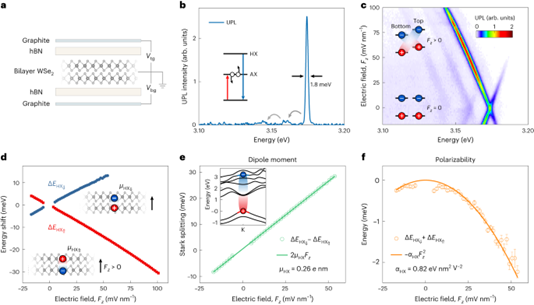Title: Ultraviolet interlayer excitons in bilayer WSe2
Authors: Kai-Qiang Lin*, Paulo E. Faria Junior, Ruven Hübner, Jonas D. Ziegler, Jonas M. Bauer, Fabian Buchner, Matthias Florian, Felix Hofmann, Kenji Watanabe, Takashi Taniguchi, Jaroslav Fabian, Alexander Steinhoff, Alexey Chernikov, Sebastian Bange & John M. Lupton
Abstract: Interlayer excitons in van der Waals heterostructures are fascinating for applications like exciton condensation, excitonic devices and moiré-induced quantum emitters. The study of these charge-transfer states has almost exclusively focused on band edges, limiting the spectral region to the near-infrared regime. Here we explore the above-gap analogues of interlayer excitons in bilayer WSe2 and identify both neutral and charged species emitting in the ultraviolet. Even though the transitions occur far above the band edge, the states remain metastable, exhibiting linewidths as narrow as 1.8 meV. These interlayer high-lying excitations have switchable dipole orientations and hence show prominent Stark splitting. The positive and negative interlayer high-lying trions exhibit significant binding energies of 20–30 meV, allowing for a broad tunability of transitions via electric fields and electrostatic doping. The Stark splitting of these trions serves as a highly accurate, built-in sensor for measuring interlayer electric field strengths, which are exceedingly difficult to quantify otherwise. Such excitonic complexes are further sensitive to the interlayer twist angle and offer opportunities to explore emergent moiré physics under electrical control. Our findings more than double the accessible energy range for applications based on interlayer excitons.

Full-Link: https://www.nature.com/articles/s41565-023-01544-7